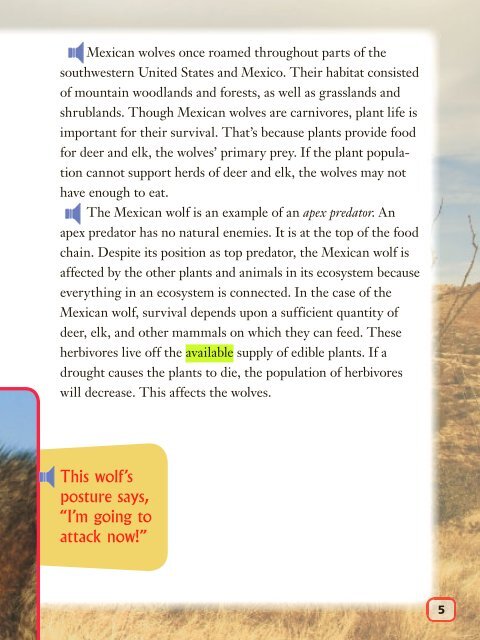Lesson 10:Saving the Mexican Wolves
Lesson 10:Saving the Mexican Wolves
Lesson 10:Saving the Mexican Wolves
- No tags were found...
You also want an ePaper? Increase the reach of your titles
YUMPU automatically turns print PDFs into web optimized ePapers that Google loves.
<strong>Mexican</strong> wolves once roamed throughout parts of <strong>the</strong>southwestern United States and Mexico. Their habitat consistedof mountain woodlands and forests, as well as grasslands andshrublands. Though <strong>Mexican</strong> wolves are carnivores, plant life isimportant for <strong>the</strong>ir survival. That’s because plants provide foodfor deer and elk, <strong>the</strong> wolves’ primary prey. If <strong>the</strong> plant populationcannot support herds of deer and elk, <strong>the</strong> wolves may nothave enough to eat.The <strong>Mexican</strong> wolf is an example of an apex predator. Anapex predator has no natural enemies. It is at <strong>the</strong> top of <strong>the</strong> foodchain. Despite its position as top predator, <strong>the</strong> <strong>Mexican</strong> wolf isaffected by <strong>the</strong> o<strong>the</strong>r plants and animals in its ecosystem becauseeverything in an ecosystem is connected. In <strong>the</strong> case of <strong>the</strong><strong>Mexican</strong> wolf, survival depends upon a sufficient quantity ofdeer, elk, and o<strong>the</strong>r mammals on which <strong>the</strong>y can feed. Theseherbivores live off <strong>the</strong> available supply of edible plants. If adrought causes <strong>the</strong> plants to die, <strong>the</strong> population of herbivoreswill decrease. This affects <strong>the</strong> wolves.This wolf’sposture says,“I’m going toattack now!”5
















